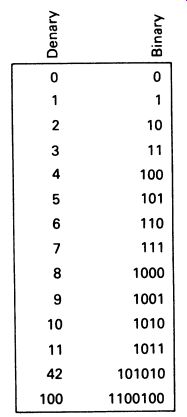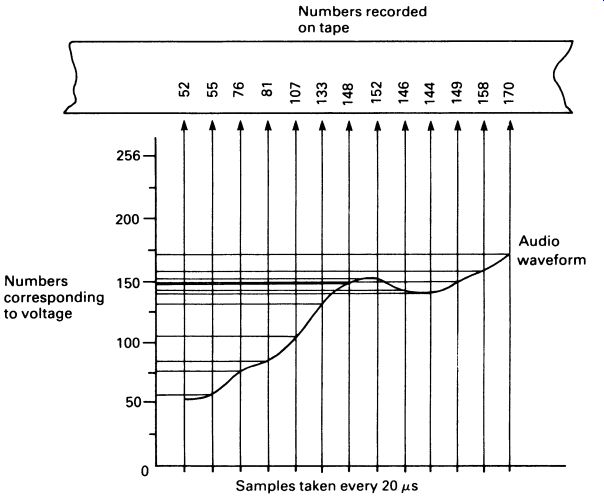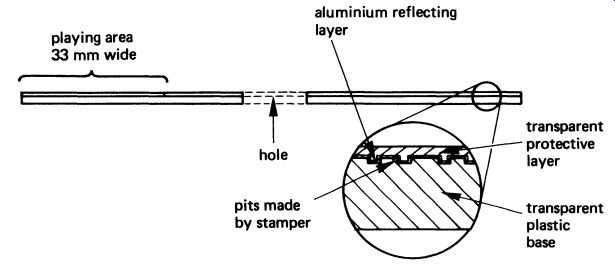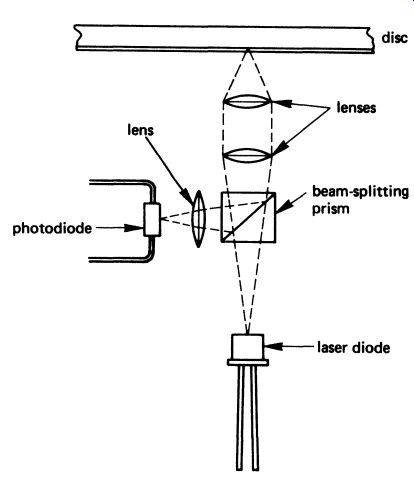AMAZON multi-meters discounts AMAZON oscilloscope discounts
Digital electronics deals with the electronic manipulation of numbers, or with the manipulation of varying quantities by means of numbers. Because it is convenient to do so, today's digital systems deal only with the numbers 'zero' and 'one', because they can be represented easily by 'off and 'on' within a circuit. This is not the limitation it might seem, for the binary system of counting can be used to represent any number that we can represent with the usual denary (0 to 9) system that we use in everyday life.
First, compare the way a digital system might be used to multiply two numbers together compared with a linear, or 'analogue', system. Let us imagine that we want to multiply 7 by 6 and arrive at the answer: 42. In an analog system we could start with a voltage of exactly 7 V. If this were fed into an op-amp with a gain of exactly 6, the output voltage could be measured accurately and it would be found to be 42 V. This kind of 'computer' is quite feasible, but has limitations. Now suppose we want to multiply 7234 by 27 300. This is a different problem. Clearly it would now be impractical to use 1 V to represent 1, so we must use, say, 1 mV to represent 1. The input to the amplifier is thus 7.234 V. There now comes the problem of the amplifier to give a gain of 27 300-a massive design problem in itself. If it could be made, and made to work, the out put would be 197 488.2 V, or nearly 200 kV! Even representing the input as 1 uV per 1, the output level would be almost 200 V-not really a practical solution, even supposing we could measure 200 V to the nearest microvolt.
A digital system, on the other hand, would treat the problem in a different way. Back to 7 times 6. Seven, in binary notation, is 111, and six is 110-see Fig. 1 for a table giving comparable denary and binary numbers. We can represent a 0 by 0 V, and a 1 by, say,+ 5 V. Both six and seven could be represented using only three wires at one of two different potentials. The answer, 42, is represented in binary as 101010, which needs six wires. To increase the capacity of the system to calculate 7234 x 27 300 simply needs more wires; 7234 in binary is 1110001000010 and 27 300 in binary is 110101010100100. Hardly a readily recognizable or convenient number for us, but it is still a way of representing a big number without having to use electronic systems needing more than a few volts.
Also, the accuracy of the system in terms of reading voltage levels is not required to be high; all that is needed is the ability to differentiate in the circuits between 0 V and + 5 V. The solution to the problem, 197 488 200, is actually a rather long binary number, 1011110001010110111001001110, 28 binary digits, or 'bits', as the computer people call them. Although binary numbers are long, the difficulty of manipulating them is nothing compared with the problems associated with the equivalent analog systems. Rather than use 28 wires, a computer or calculator would use a register holding the 28 'ons' and 'offs' in bi-stables, and the digits would be processed in sequence rather than altogether, but such details are part of computer science, not mastering electronics! Digital systems clearly have big advantages.

FIG. 1 some denary numbers with their binary equivalents A circuit
involved in storing and manipulating binary numbers is rather complex,
but in much the same way as a knitted sweater is complex, containing
as it does a very large number of similar units. Digital systems remained
the province of the specialist until the advent of microelectronics.
Digital systems are perfect for making as integrated circuits. They have large numbers of regular circuit elements, they can be made without capacitors or inductors, and they can be made to use any convenient voltage. With mass-produced ICs containing complicated circuits available for the same price as a single transistor, it has now become possible to use digital techniques in all sorts of applications that were previously the province of analog systems.

FIG. 2 a digital recording technique
Take digital sound recording, for example. Hi-fi sound has long been associated with the very best of linear electronics. Tape-recorders in particular have undergone spectacular developments to bring them to the present quality and cheapness-but it is digital systems that are now used to make the 'masters' for records and tapes, in the best studios. Fig. 2 shows a very small part of an audio waveform. This could be reproduced with very little distortion on the best tape-recorders available. But using digital recording techniques the waveform is chopped into brief time intervals (more than twice the highest audio frequency), and the voltage level measured at that point in time. The voltage level is assigned a numerical value--8 bits would give 256 different numbers--from zero to maximum level. The numbers are recorded in binary form on a tape, at a rate (in this example) of somewhere over 300 000 bits per second.
To replay the tape, the numbers are turned back into voltage levels, and the original waveform reconstructed from the numbers. This may seem a complicated way of recording a concert, but the beauty of it is, if it works at all, it's perfect-or as near perfect as it needs to be.
A digital recording can be re-recorded over and over again, copied, re-copied, mixed, re-mixed, and if the numbers are readable (and they are read only as 'on' and 'off’), the music will be as perfect as the first recording, with no degradation whatsoever, and no background noise caused by successive re-recordings.
Digital recording is, it must be admitted, a rather 'high-technology' application of digital electronics. But digital systems are used in much simpler contexts, and there are surprisingly few different circuit elements in even the most elaborate system.
It is inevitable that digital electronic systems should lead to a study of computers and their organization, for the digital computer is perhaps the greatest achievement of digital electronics technology. The following sections, and the final section of this guide, deal with digital circuit elements and complete systems, and, in the last two sections, with micro· processors and digital computers. But you should remember that digital electronics covers not only computers but also a whole vast area of designs and ideas that make use of the ready availability of cheap digital integrated circuits.
1. DIGITAL AUDIO
One of the more impressive advances of digital electronics into the 'consumer' market has been the advent of the CD, or compact disc player. This is an entirely digital system that has provided a major advance in hi-fi audio reproduction. The CD system uses a 16-bit system, providing 65 536 different voltage levels, and a sampling rate of 44.1 kHz. Apart from the fact that nothing is lost between the original master recording and the millionth copy, the performance figures are, to the hi-fi enthusiast, quite compelling. Total harmonic distortion is 0.005%, compared with the best record at 0.15%. Signal-to-noise ratio is 90 dB, compared with the best record and player combination of 60 dB. Channel separation (that is, the amount of unwanted mixing that takes place between left and right stereo channels) is almost perfect at 90 dB, compared with a good record at 30 dB. Wow and flutter (variations in speed that affect the pitch or quality of the sound) are completely absent in the CD system.
On its own, recorded on tape, this kind of digital recording would be a big advance, but in the CD system it is combined with a new and better way of recording and playing back the digital information at the required minimum speed of almost a megabit (1 million bits) per second.
The compact disc is smaller than an LP record--only 120 mm diameter.
It is played on one side only, but gives an hour's playing time. The recording is made in the usual spiral form, but starts from the middle, and is incredibly compact, with as many as 20 000 tracks across the 33 mm playing radius. The digital information is recorded as a series of tiny pits in a transparent plastic base, protected with a second layer of transparent plastic of different refractive index. A thin reflective layer of aluminum is also added. The diffraction effects give the CD its characteristic 'rainbow' appearance, and make it beautiful as well as efficient. Fig. 3 shows the CD in section.

FIG. 3 section through a compact disc
The pits are very small indeed, only about 0.5 um in diameter and 0.2 um deep, but are not easily damaged as they are protected by plastic on both sides. The pits are scanned by a focused light beam from a laser diode. A laser diode is used because the light from it is emitted at a single wavelength, is coherent (see Section 16.8) and is very directional, making it possible to focus it very sharply with a fairly simple optical system. The pits on the compact disc are always scanned at the same rate, so the disc has to spin faster when tracks near the middle are being scanned than when tracks near the edge are under the laser. The disc spins at a rate between about 200 and 500 revolutions per minute, over 4 million pits passing the laser every second. The minimum information rate mentioned above is easily exceeded, leaving extra capacity for all sorts of 'extras' like track number and time elapsed since the beginning of the disc.
Fig. 4 shows a typical layout for the laser scanner. The laser 'pick-up' has to be guided very accurately, and all motions are feedback controlled. The distance between the scanner and the disc has to be exactly constant, the disc has to rotate at the right speed for any track, and--most difficult of all--the scanner has to follow the line of pits exactly even if the disc is not exactly concentric. Remember that the 'tracks' are only about 1.5 um wide! Different manufacturers have developed different systems for controlling the scanner, but all involve high speed and extreme accuracy.
The complete lack of wow or flutter on the CD system may at first seem puzzling; after all, the disc is spun by a motor just like a turntable.

FIG. 4 diagram of the optical system of the CD scanner.
The reason is that minor variations in the disc speed will not affect the sound at all, for the disc is simply supplying data. The rate at which the data is translated into sound (the sampling rate) is controlled by the electronic circuits and is always exactly constant.
Unlike recording tapes, compact discs can be duplicated with a stamper, just like a gramophone record. The original is made using a high-powered laser to burn the pits into a special coating on a glass master disc. This is then used to make further masters from which the plastic discs are molded.
The process is much quicker and more reproducible than recording on tapes, where there is always a balance to be struck between speed and quality of recording.
The electronic systems used in CD players are very complex and sophisticated, and could not have been developed for domestic use even five years earlier. In 1986 CD players represent, as they say, the 'state of the art' for this kind of product, well beyond the scope of this introductory book. But you have to begin somewhere, and the rest of this work deals with the basics of digital electronics and computing, from which everyday miracles like compact discs have developed.